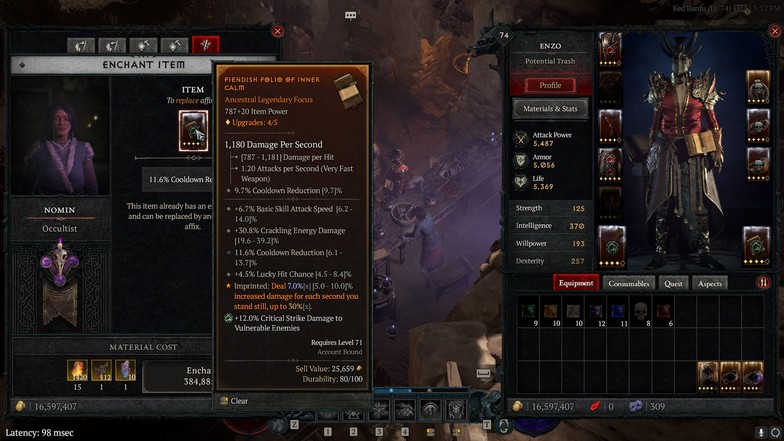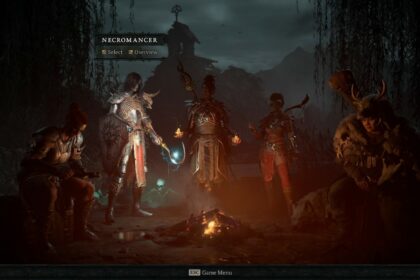Beating Lilith signifies the end of Diablo 4’s campaign. You might finish the campaign around level 38-50, but the fun starts after the campaign.
There are hundreds of hours left to play after the campaign, but it depends on what your overall goal is in the game.
In this guide, we’ll show you what is in store for you after completing the game’s final boss. This includes your progression into the endgame, such as paragon levels, item farming, and world completion.
Midgame Gearing

You’ll receive a priority quest upon clearing the campaign, which unlocks nightmare difficulty. The quest takes you to the first capstone dungeon, and you have to finish it to unlock the next tier.
If you are having trouble finishing the capstone dungeon, you should keep doing your Tree of Whispers dungeons, collecting rewards, and leveling up.
It is recommended that you are around level 50, but if you can destroy monsters at an earlier level, you should do the quest immediately.
Once you have unlocked nightmare difficulty, you should find yourself a new weapon for that insane DPS increase.
Sacred items will start dropping in tier 3 difficulty, and it should be your main priority to replace every item to sacred tier.
This is the first step to start your endgame. You’ll keep finding these sacred items in the next difficulty as well as a new way to farm in nightmare dungeons.
These nightmare dungeons are unlocked when you get your first sigil drop. These sigils drop in any dungeon in nightmare difficulty. They are pretty easy to get, and you could even craft these sigils eventually.
Keep grinding all these nightmare dungeons until the next step.
Endgame Gearing

The endgame gearing progression is essentially the same as the previous one. You’ll want to finish the next capstone dungeon with monsters around level 73.
You can finish the dungeon at an earlier level if you have enough player level. I was able to finish the last capstone dungeon to unlock torment difficulty at level 59.
The goal is to unlock the next difficulty as fast as possible so you can get your hands on the next tier of items: ancestral items.
Like in the midgame section, you’ll have to grind the current content your player can clear until you can unlock tier 4.
When you unlock the torment difficulty, you want to find a weapon again for that insane DPS increase.
Once you get that weapon, you should be able to clear nightmare dungeons at a faster rate (tier 26+ for torment difficulty).
At this point, you’ll continue to keep grinding higher and higher tiers of nightmare dungeons until you reach level 100.
If you want efficiency in leveling, it’ll be finishing nightmare dungeons 10 levels above you at a very fast pace.
Post-campaign Progression Tips
Item level 725 benchmarks

Each item has a corresponding item level attached to it. This item level determines the power of the item and its stat rolls.
Diablo 4 has a hidden mechanic where if an item reaches item level 725, all the rolls get a tier up in stat rolls.
The trick is that when you receive ancestral items with item levels 710-724, you can upgrade your item to reach that benchmark and boost the stats.
This is an insanely useful tip for finding gear when starting out in torment difficulty. Some items can get the perfect rolls for your build but might not be strong enough compared to your current item.
If you account for the boosted stats when the item reaches past item level 725, it can potentially be better than your item.
Enchanting Rerolls

Enchanting items with the occultist gives you more chances at find great gear. You have to be extremely lucky to find a gear with absolutely the perfect stats for your build.
With the enchanting feature, you only have to hit 3 good stats because you can always reroll the other stat through enchanting.
However, enchanting doesn’t exactly guarantees a good stat. When you enchant, you’ll be choosing a stat to reroll and you’ll be given three different choices: keep the same rolll or two random stat rolls.
If you ever get your hands on great gear that could be better, you can always enchant it.
Sacred and ancestral items does cost Forgotten Souls to enchant and some gold. If you enchant the item more than once, the gold cost will cost way higher.
You want to enchant semi-decent rolled items once, and if you don’t get what you need, you can throw it out.
If you do have three of the best stats and one terrible stat, it is worth rerolling until you get the perfect item.
Now, you’ll find yourself needing a ton of Forgotten Souls, which brings us to the next tip.
Helltide
Helltide events occasionally shows up on your map. If it is active, it is best to farm the event as many times as possible.
The main purpose of farming Helltide is to farm these Forgotten Souls, but it does have other benefits.
You can get loot of your gear type choice by opening chests with Aberrant Cinders. These chests gives you a great chance for legendaries and also give you materials.
These materials add up because they can be pretty useful in crafting, enchanting, upgrading, or even sustaining good elixirs.
If you have a lot of Forgotten Souls, you can go back to farming nightmare dungeons.
Region Progress
If you do get bored on doing nightmare dungeons, you can always explore the world and complete your region progress.
While this isn’t mandatory, unlocking an additional skill point from the 3rd region progress reward is useful to most builds out there.
Completing these milestones on each region will net you at least 5 additional skill points, which is big in terms of player level.
When you reach the endgame gearing progression, you’ll start to feel that every little point you can get from power counts.
These include things like elixirs, attribute buffs from Lilith altars, extra skill points, extra paragon points, and even incense buffs for party play.






